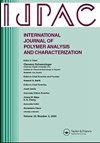DGEBA-APTES-ZrO2纳米复合防腐蚀防污涂层的研制与表征
IF 1.7
4区 工程技术
Q4 POLYMER SCIENCE
International Journal of Polymer Analysis and Characterization
Pub Date : 2023-08-18
DOI:10.1080/1023666X.2023.2254034
引用次数: 0
摘要
采用四乙基四胺(TETA)、3-氨基丙基乙氧基硅烷处理的ZrO2纳米颗粒和双酚a二缩水甘油酯(DGEBA)制备了环氧纳米复合材料(DGEBA- aptes -ZrO2)。采用FTIR、XRD、SEM、AFM、TEM和元素分析对新合成的APTES-ZrO2进行了结构和成分分析。由于其在酸性、碱性和盐水条件下的弹性,低碳钢在造船和汽车工业等行业至关重要。ZrO2纳米颗粒具有优异的耐腐蚀性。因此,打算制备DGEBA-APTES-ZrO2作为防止低碳钢表面腐蚀的屏障层。FTIR光谱测试证明了dgeba - aptes - zro2涂层低碳钢具有限制腐蚀和微生物生长的能力。采用盐雾和电化学阻抗技术对其缓蚀性能进行了评价。在低碳钢表面,DGEBA-APTES-ZrO2纳米杂化涂层表现出优异的防腐蚀和防污性能。本文章由计算机程序翻译,如有差异,请以英文原文为准。
Development and characterization of DGEBA-APTES-ZrO2 nanocomposite coatings for anti-corrosion and anti-fouling
Tetraethylenetetramine (TETA), 3-aminopropylethoxysilane-treated ZrO2 nanoparticles, and diglycidyl ethers of bisphenol-A (DGEBA) were used to create an epoxy nanocomposite (DGEBA-APTES-ZrO2). The newly synthesized APTES-ZrO2 was evaluated using FTIR, XRD, SEM, AFM, TEM and elemental analysis for structural and compositional analysis. Due to its resilience in acidic, basic and saline conditions, mild steel is crucial in sectors like shipbuilding and the automobile industry. ZrO2 nanoparticles have excellent corrosion resistance. As a result, it is intended to prepare DGEBA-APTES-ZrO2 for a barrier layer that prevents corrosion on mild steel surfaces. FTIR spectroscopy tests provided proof of DGEBA-APTES-ZrO2-coated mild steel’s ability to limit corrosion and microbiological growth. Using salt spray and an electrochemical impedance technique, corrosion inhibition was evaluated. On mild steel surfaces, DGEBA-APTES-ZrO2 nanohybrid coatings demonstrated excellent corrosion prevention and antifouling.
求助全文
通过发布文献求助,成功后即可免费获取论文全文。
去求助
来源期刊
CiteScore
3.50
自引率
5.30%
发文量
37
审稿时长
1.6 months
期刊介绍:
The scope of the journal is to publish original contributions and reviews on studies, methodologies, instrumentation, and applications involving the analysis and characterization of polymers and polymeric-based materials, including synthetic polymers, blends, composites, fibers, coatings, supramolecular structures, polysaccharides, and biopolymers. The Journal will accept papers and review articles on the following topics and research areas involving fundamental and applied studies of polymer analysis and characterization:
Characterization and analysis of new and existing polymers and polymeric-based materials.
Design and evaluation of analytical instrumentation and physical testing equipment.
Determination of molecular weight, size, conformation, branching, cross-linking, chemical structure, and sequence distribution.
Using separation, spectroscopic, and scattering techniques.
Surface characterization of polymeric materials.
Measurement of solution and bulk properties and behavior of polymers.
Studies involving structure-property-processing relationships, and polymer aging.
Analysis of oligomeric materials.
Analysis of polymer additives and decomposition products.

 求助内容:
求助内容: 应助结果提醒方式:
应助结果提醒方式:


